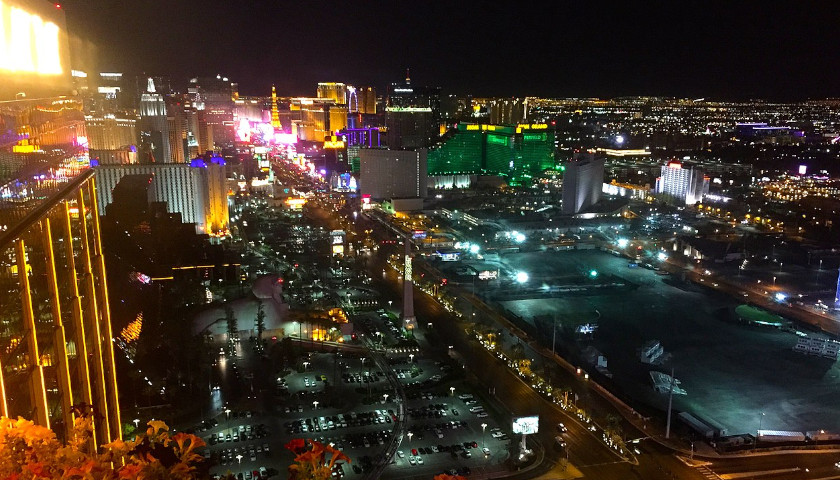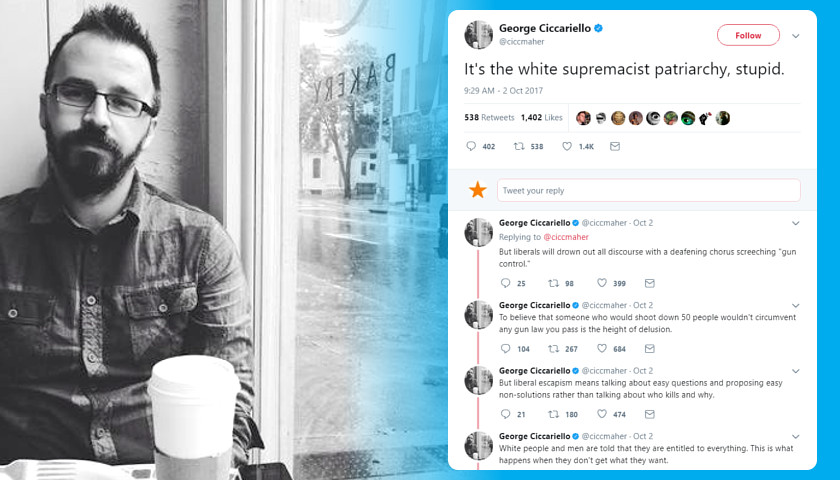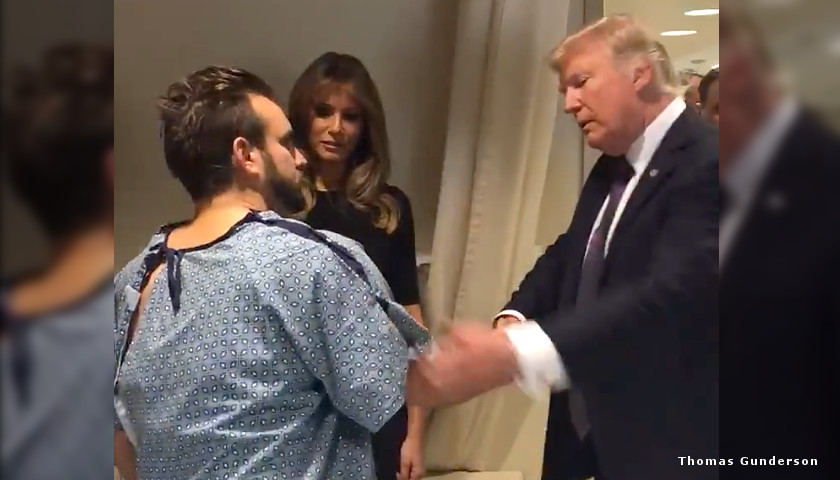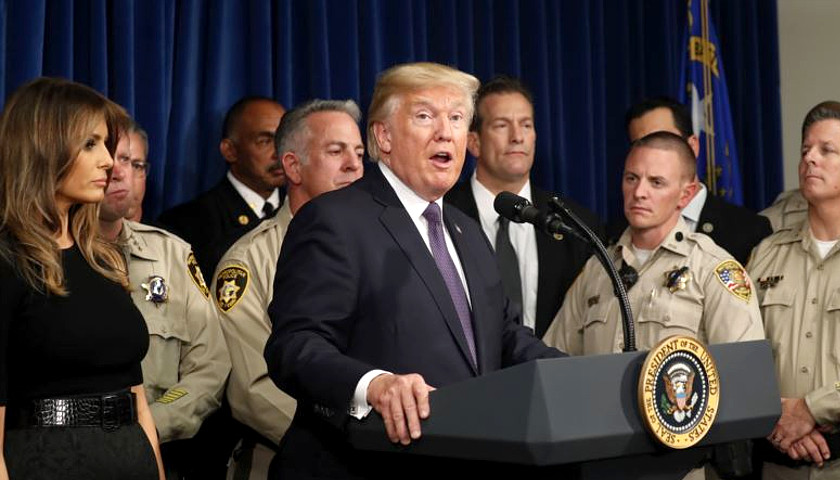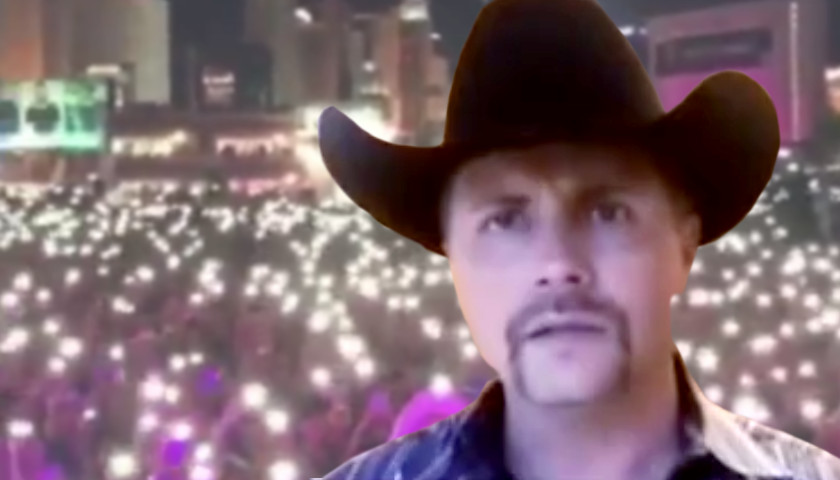by Richard Pollock
Seasoned law enforcement and military experts contacted by The Daily Caller News Foundation have expressed serious doubts about the thoroughness of the Las Vegas Metropolitan Police Department’s preliminary report about the deadliest mass shooting in American history.
In releasing the interim report Jan. 18, Clark County Sheriff Joseph Lombardo stressed it was not his department’s “standard practice” to release a report on an open case, but he “felt it was important” to release an “overview” due to the high number of victims in the Oct. 1 mass shootings when Stephen Paddock killed 58 people and wounded more than 700.

With an arsenal of 18 AR-10 and AR-15 rifles in two hotel rooms, Paddock targeted concertgoers attending an open-air country music concert across from the Mandalay Bay Resort and Casino in Las Vegas. About 22,000 people attended the concert, which Paddock quickly turned into a killing ground.
Lombardo added that the department’s findings are “not intended to be a comprehensive and final account of the facts and evidence gathered.” A final report will be released, but no date has been set.
Larry Hadfield, a Las Vegas Metropolitan Police Department (LVMPD) public information officer informed TheDCNF Jan. 30 that the department had no further information to provide about the shooting and refused to answer any of the questions submitted by TheDCNF in a Jan. 22 email.
“We are unable to answer any of your questions at this time,” Hadfield said.
However, the interim nature of the report did not satisfy veteran law enforcement and military experts contacted by TheDCNF.
“This report gives you more questions than it gives you more answers,” concluded Ron Hosko, former assistant director of the FBI, in an interview with TheDCNF. “I’m just scratching my head.”
“Nearly four months after the massacre, the inquiry into the largest mass shooting in modern American history is still mired in questions,” CNN wrote after the release of the preliminary report,
The pathology report shows a normal 64-year old slightly overweight man. The toxicology report showed evidence of Nordiazepam, a sedative, Oxazepam, an anti-anxiety drug also used for alcohol withdrawal, and Temazepam, used for sleep disorders. Caffeine was in his bloodstream, but there was no presence of alcohol.
[pdf-embedder url=”http://battlegroundstatenews.com/wp-content/uploads/2019/02/Vegasautopsy.pdf”]
TheDCNF reached out to three experts with law enforcement and military experience to review and assess the Las Vegas Police Department’s preliminary report into the shooting.
They are:
- Ron Hosko who retired in 2014 as the FBI’s assistant director of the Criminal Investigative Division, capping a 30-year career at the bureau. He served as the bureau’s inspector who conducted investigations into serious and fatal shootings by the FBI. Hosko was awarded the FBI’s Shield of Bravery for his actions during a violent ransom kidnapping. He was the special agent in charge of the FBI’s Washington, D.C. Field Office and was in charge of its criminal division. He currently is the president of the Law Enforcement Legal Defense Fund.
- Wayne Black is a law enforcement official with 40 years of experience in law enforcement and private security. He has conducted many after-action murder investigations and was the only American investigator to officially review the death of Princess Diana. He currently provides private security services.
- Brian Gould is a 20-year veteran with the U.S. Army of which 17 years was with U.S. Special Forces. For eight years he was attached to a unit within Special Forces called the “Commanders and Extremist Force” that specialized in direct action, special reconnaissance and counter-terrorism. He also served as a senior strategic planner at Special Operations Command at U.S. Central Command. Gould also spent five years on a special military unit that investigated war criminals in Europe.
All three experts agreed the report sidestepped many issues surrounding the shooting. “There a lot of inconsistencies that just don’t line up with the narrative,” Gould said. “I don’t want to sound too sarcastic about it, but I think they’re just trying to cover their ass with this report.”
“They got the shooter. I think they’re happy with that ending … But there are a lot of questions that leave a lot of holes in this investigation,” he told TheDCNF.
“This report begs the questions from anyone who has investigative experience,” added Black.
“I think everybody wants to have closure,” Black said. “The people in Las Vegas who make a living from tourism wanted to be able to say, ‘well that’s over with.’ These guys are probably saying, ‘we got to give these guys something, so let’s give them a generic piece and see if it works.”
The LVMPD, not the FBI, now is the lead agency in the shooting, according to Sandra Breault, the FBI spokeswoman in Las Vegas. “Metro remains the lead investigative agency,” she told TheDCNF.
Here are some of the more important questions TheDCNF experts said were not properly addressed by the police.
Still Unanswered: What Was Paddock’s Motive?
Hosko, a former top FBI official, was blunt in his assessment. “They haven’t gone into the why,” he said. “Tell me more about what was driving this guy. They interviewed many witnesses. What did they say? That part’s not in there. There’s no substantive part that tries to explain ‘why.’”
CNN also raised the lack of motive for Paddock’s shooting as a weakness in the preliminary report.
“Nearly four months after the massacre, the inquiry into the largest mass shooting in modern American history is still mired in questions; chief among them: Why did Paddock do it?” asked the cable news organization.
Lombardo admits LVMPD has been unable to ascertain Paddock’s motive. “Nothing was found to indicate motive on the part of Paddock,” the report states.
“This report is not going to answer every question or even answer the biggest question, as to why he did what he did,” Lombardo said at a press conference announcing the release of the preliminary report.
ISIS twice claimed that the shooter was carrying out the attack on its behalf. Its Amaq “news service,” asserted he was a “soldier of the Islamic State who carried out the attack in response to calls for targeting coalition countries,” and later claimed the shooter “converted to Islam months before the attack,” Michael S. Smith II wrote in an article published in Foreign Affairs.
Smith, a terrorism analyst who is a fellow at the New America Foundation, a centrist think tank, reported ISIS claimed that “the shooting was in response to ISIS leader Abu Bakr al-Baghdadi’s call for attacks ‘targeting the crusader alliance’ and that Paddock allegedly conducted “careful monitoring of the Crusader gatherings in the city of Las Vegas.”
But the analyst also noted it could be disinformation, stating, “it is not without precedent for the Islamic State to issue boldly misleading statements about important events,” according to USA Today.
There also were claims Paddock was tied to a left-wing Melbourne, Australia, Antifa group. On a Facebook post since deleted, the group claimed responsibility for the attack. “One of our comrades from our Las Vegas branch has made these fascist Trump supporting dogs pay,” the Daily Mail reported.
Both sets of charges have been hotly disputed by experts, media and law enforcement sources, including the Las Vegas police. The police department flatly states in its report that “Paddock acted alone.” The report also asserts he left behind no manifesto, no suicide note or showed “evidence” of radicalization.
Still, the attack was not a spontaneous outburst but a meticulously planned shooting. Paddock was sophisticated — he had a pilot’s license and was certified for night flying. He also served as an auditor for Lockheed Martin and Boeing as well as an IRS agent.
“Paddock planned the attack meticulously and took many methodical steps to avoid detection of his plot and to thwart the eventual law enforcement investigation that would follow,” according to FBI search warrants obtained and reported by The New York Times last month.
TheNYT reported that Paddock tried to elaborately cover his tracks when he “destroyed or tried to hide digital media devices” and used anonymous communications devices, including a prepaid cell phone.
The killer also set up a surveillance system in the hallway outside his two suites using food carts. “The fact is he was smart — smart enough to set up surveillance in the hallway and on the door,” Gould said.
Both the FBI and LVPMD suggest the Las Vegas attacker also searched other potential targets around the country.
Police found he searched for terms relating to “‘summer concerts 2017,’ ‘grant park functions,’ ‘biggest bear,’ ‘La Jolla Beach,’ ‘open air concert venues,’ ‘biggest open air concert venues in USA,’ and “how crowded does Santa Monica Beach get,’” according to an examination of his Google history.
“Paddock had a reservation for a hotel during the Lollapalooza music festival held at Grant Park in Chicago, Illinois during the month of August,” and he “made lodging reservations during the Life is Beautiful music festival” held a week earlier in downtown Las Vegas, the report added.
Yet while all law enforcement agencies agree the attack was highly organized, they are still unable to answer the question on many people’s minds: Why did Paddock meticulously plan and methodically shoot and kill large numbers of people?
A Psychological Profile of Paddock is Missing
“Whoever prescribed, whoever consulted this guy on the couch, that’s the sort of information we need, whether through a court order or however we get it,” Hosko said.
“Lay that part out for me. And even in an interim report, give us an interim snapshot of what’s going on through this guy’s head other than the last round. To me this is significant and it’s omitted here,” said Hosko.
The Las Vegas police claim they conducted an extensive investigation into his background. “Every facet of Paddock’s life was explored,” their report reads.
The police claim that Marilou Danley, Paddock’s girlfriend, said the shooter appeared to have changed over the year before the shooting. The Las Vegas police concluded, “Paddock’s demeanor changed over the course of the last year. According to her, Paddock had become ‘distant’ and their relationship was no longer intimate. Paddock was described as ‘germaphobic’ and had strong reactions to smells.”
The report also noted he constantly felt ill. “Paddock made numerous claims to friends and family that he consistently felt ill, in pain or fatigued.” His primary care physician “recalled the only major ailment Paddock had was a slip and fall accident at a casino approximately 3 years earlier, which caused a muscle tear.”
“The physician described Paddock as ‘odd’ in behavior with ‘little emotion’ shown. He believed Paddock may have had bipolar disorder however, Paddock did not want to discuss that topic further with him,” the reports states.
Yet there is no comprehensive information about Paddock’s medical history, his prescription drug use, or a mental health record.
No Substantial Financial Profile
Hosko believes the financial profile is critical in understanding Paddock.”Where is there any kind of financial snapshot? It’s a big piece that’s missing,” he said.
On the day of the preliminary report’s release, Sheriff Lombardo admitted finances could have been one possible motive for his actions.
“I’ve put out in the public space that he had lost a significant amount of his monetary wealth in close proximity to 1 October and that may have a driving factor associated with it,” he told reporters on the same day he released the report.
The interim reported on his obsession with gambling. “Most of the people interviewed acknowledged Paddock’s gambling habits. Paddock was known to gamble tens of thousands of dollars at a time and played at numerous casinos.”
But the police report only devoted a single paragraph to his financial history, stating: “One aspect of the investigation focused on Paddock’s financials. The investigation proved Paddock was self-funded through his gambling and past real estate transactions. He was indebted to no one and in fact paid all his gambling debts off prior to the shooting.”
The note that the shooter paid off all his debts also raises new questions. If he knew he was going to die, why would he pay all his debts? If he’s going out in a blaze of glory, wouldn’t it make sense that he would max out his credit cards?
Aside from being an avid gambler, the shooter also had expertise in financial matters. He served as an IRS agent and an auditor for Lockheed Martin and Boeing.
Paddock owned residences in Mesquite and Reno, Nevada, which now are tied up with numerous civil suit by victims who want to obtain some of his remaining funds.
But aside from a few brief references, there is absolutely no financial profile of Paddock. There is no review of his loans, spending habits, investments, business partnerships, mortgages, and the size of his various gambling debts, according to TheDCNF reviewers.
Missing: Photos and Videos
Black said the lack of photos tied to Paddock’s activities while at the hotel is disturbing. “The missing pictures are more important than the pictures they released. They took hundreds if not thousands of pictures,” he charged.
In their report, the police acknowledge they obtained 21,560 hours of video and 251,099 photo images. But there are no photos tied to the time while Paddock was actually observed in Las Vegas or at the Mandalay Bay resort hotel.
Paddock checked into the Mandalay Bay hotel on the afternoon of September 25 into a large suite on the 32nd floor in Room 32-135 and in the adjoining smaller bedroom in Room 32-134.
Significantly, there are no photos of his many trips to and from the hotel’s garage as he moved guns into the hotel. In all, he carried 18 AR-10 and AR 15 rifles and hundreds of pounds of ammunition housed in bulky gun magazines. More than 5,000 rounds of unused ammunition was found in his room after police stormed the large suite.
“Did they pick him up on any cameras as he moved all those gun cases throughout the hotel?” Black asked. “If so, where are they?”
On the day he checked in on September 25, Paddock brought in five bags. During the evening of Sept. 26, police report Paddock brought more bags, including “six suitcases (located on a luggage cart) and one rolling suitcase (Paddock rolled the suitcase himself) up to room 32-135 by way of the service elevator with help of a bellman.”
Paddock heavily gambled at the casino in Mandalay Bay from Sept. 27 onward. On that day, police noted that “at approximately 0713 hours, Paddock stopped gambling, which he was doing continuously since the previous night.” The next evening they reported, “At approximately 2218 hours, Paddock began gambling at Mandalay Bay and continued gambling into the next morning.”
On Sept. 30, the police report stated, “at approximately 0556 hours, Paddock returned to the Mandalay Bay with four suitcases,” and later, “Paddock was observed exiting the parking garage elevator with two suitcase rolling bags.”
On that same day for two hours, “Paddock walked around and gambled at the El Cortez Hotel.”
On Oct. 1, the actual day of the shooting, “From approximately 0324 to 0734 hours, Paddock walked around the casino and gambled.” Later that day, “Paddock was observed waiting for an elevator with two rolling suitcases. There was also a third bag hanging from one of the rolling suitcases,” police reported.
But a review of the photo gallery attached to the report shows the police failed to attach any photo of these activities.
Moreover, there are two important missing photos from the report’s photo gallery. While the police decided to post a photograph of the shooter’s view from room 323-135, the large suite, there are none of the view from room 32-134.
Similarly, while the police released a photo of the smaller room bedroom room 32-134, they failed to include a photo of the master bedroom in the larger suite, 323-135.
Finally, the photos, toxicology reports and other materials not included in the LVMPD report could help establish the timeline and work to combat some of the conspiracy theories arising in the wake of America’s deadliest mass shooting.
The police department has not pledged a date when the final report will be released.
– – –
Richard Pollock is a reporter for the Daily Caller News Foundation. Follow Richard on Twitter.
Photo “Las Vegas Night” by Jennifer Morrow. CC BY 2.0.

